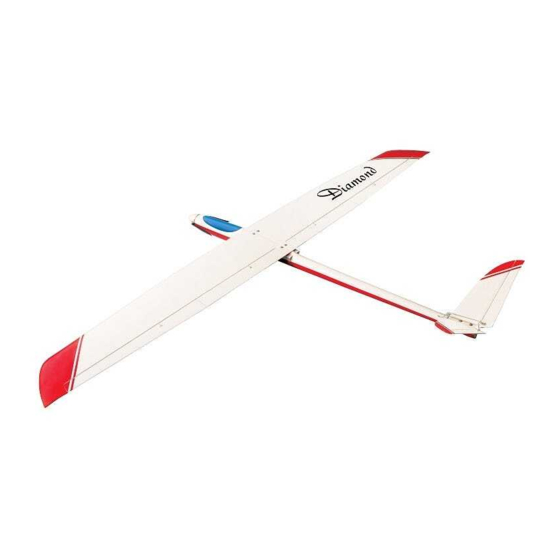
Table of Contents
Advertisement
Quick Links
Diamond
ELECTRIC GLIDER ARF
SPECIFICATION
- Wingspan: 2020mm (79.5 in)
- Length: 1237mm (48.7 in)
- Flying weight: 1500-1600gr
- Wing area: 36 dm2
- Wing loading: 40-45 g/dm2
- Wing type: RG airfoils
- Covering type: Genuine ORACOVER®
- Radio: 6 channel – 6 mini servo: 2 aileron;
2 flap; 2 elevator (not included)
- Propeller: suit with your engine
- Motor: brushless outrunner 400-500W, 920 KV
- Gravity CG: 75-80 mm (3,1 in) Back from
the leading edge of the wing, at the fuselage
Instruction Manual
- Control throw aileron: Low: 6mm right/left,
- Control throw Elevators: Low: 6mm up/down,
- Experience level: Intermediate
- Plane type: Sailplane
RECOMMENDED MOTOR AND BATTERY SET UP
- Motor: OS OMA-3810-1050 Or Xpower C3520/12
- Propeller: 12x8 foilding (not included)
- Lipo cell: 3 cells / 2000 – 2400mAh (not included)
- Esc: 40-60A (not included)
15% expo; High: 8mm right/left, 15% expo
12% expo; High: 8mm up/down, 12% expo
(not included)
Advertisement
Table of Contents

Summary of Contents for Phoenix Model Diamond
-
Page 1: Instruction Manual
Instruction Manual Diamond ELECTRIC GLIDER ARF SPECIFICATION - Wingspan: 2020mm (79.5 in) - Control throw aileron: Low: 6mm right/left, - Length: 1237mm (48.7 in) 15% expo; High: 8mm right/left, 15% expo - Flying weight: 1500-1600gr - Control throw Elevators: Low: 6mm up/down, - Wing area: 36 dm2 12% expo;... -
Page 3: Tools And Supplies Needed
Please trial fit all the parts. Make sure you have the correct parts and that they fit and are aligned properly before gluing! This will assure proper assembly. The DIAMOND ELECTRIC GLIDER ARF is hand made from natural materials, every plane is unique and TEMPORARY PIN minor adjustments may have to be made. -
Page 4: Installing The Aileron Servos
Instruction Manual DIAMOND INSTALLING THE AILERON SERVOS 5. Using the thread as a guide and using masking tape, tape the servo lead to the end of the 1. Install the rubber grommets and brass eyelets thread: carefully pull the thread out. When you onto the aileron servo. -
Page 5: Installing The Control Horns
Instruction Manual DIAMOND INSTALLING THE CONTROL HORNS 1. One aileron control horn in positioned on each aileron. Using a ruler and a pen, locate and mark the location of the control horn. It should be mounted on the bottom side of the aileron at the leading edge, in line with the aileron pushrod. -
Page 6: Installing The Horizontal Stabilizer
Instruction Manual DIAMOND To the cowl To the cowl INSTALLING THE HORIZONTAL STABILIZER 7. Repeat step # 1 - # 6 to install the second aileron linkage. After both linkages are 1. Using a modeling knife, cut away the covering completed, connect both of the aileron servo from the fuselage for the stabilizer and remove it. -
Page 7: Installing The Elevator, Pushrod
Instruction Manual DIAMOND 8. After the epoxy has fully cured, remove the 5. Attach the wing to the fuselage as picture. masking tape or T-pins used to hold the stabilizer in place and carefully inspect the glue joints. Use more epoxy to fill in any gaps that... - Page 8 Instruction Manual DIAMOND 5. Install the metal connector to the servo arm of 2. Locate the long piece of wire used for the the elevator servo. elevator pushrod. One end of the wire has been pre-bend into a “Z “ bend at factory. This ”Z”...
- Page 9 Instruction Manual DIAMOND INSTALLing the engine INSTALLing the battery and recEIver 1. Secure the motor. Battery glue the plastic cover 2. Secure the aluminum hub to the adafter. C.A glue 3. Screw the nut and secure it by C.A glue.
-
Page 10: Lateral Balance
Instruction Manual DIAMOND 3. Turn the airplane upside down. Place your fingers on the masking tape and carefully lift the plane . 4. If the nose of the plane falls, the plane is nose Aileron Control heavy. To correct this first move the battery pack further back in the fuselage. - Page 11 I/C FLIGHT WARNINGS Always operate in open areas, away Keep all onlookers (especially small from factories, hospitals, schools, THE PROPELLER IS DANGEROUS children and animals) well back from buildings and houses etc. NEVER fly Keep fingers, clothing (ties, shirt the area of operation. This is a flying your aircraft close to people or built sleeves, scarves) or any other loose aircraft, which will cause serious...
- Page 12 I/C FLIGHT GUIDELINES Operate the control sticks on the When ready to fly, first extend the transmitter and check that the control transmitter aerial. surfaces move freely and in the ALWAYS land the model INTO the CORRECT directions. wind, this ensures that the model lands at the slowest possible speed.















Need help?
Do you have a question about the Diamond and is the answer not in the manual?
Questions and answers